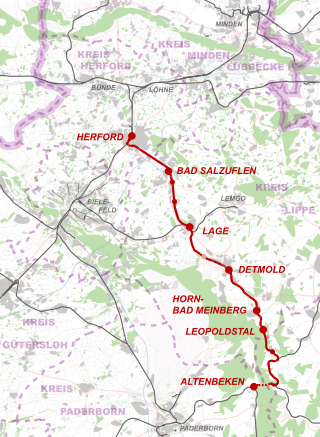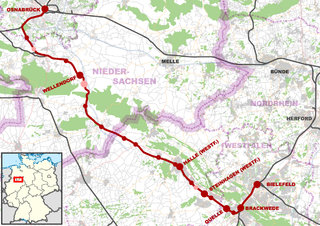
Barsinghausen is a town in the district of Hanover, in Lower Saxony, Germany. It is situated at the Deister chain of hills approx. 20 km west of Hanover. Barsinghausen belongs to the historic landscape Calenberg Land and was first mentioned in 1193.

Hannover Hauptbahnhof is the main railway station for the city of Hanover in Lower Saxony, Germany. The railway junction is one of the 21 stations listed as a railway Category 1 station by DB Station&Service. It is also the most important public transport hub of the region of Hanover and it is served regional and S-Bahn services. The station has six platforms with twelve platform tracks, and two through tracks without platforms. Every day it is used by 250,000 passengers and 622 trains stop at the platforms. About 2,000 people work here.

The Hanover S-Bahn is an S-Bahn network operated by Transdev Hannover in the area of Hanover in the German state capital of Lower Saxony. It went operational shortly before Expo 2000 and is focused on the Hanover region, and also connects with adjacent districts, and into the state of North Rhine-Westphalia. The S-Bahn is an evolution of a suburban railway.

The Hanover–Minden railway is one of the most important railways in Lower Saxony and railway in Germany. It connects the capital of Lower Saxony, Hanover via Wunstorf, Stadthagen and Bückeburg with Minden, Osnabrück, Amsterdam and the Ruhr.

Bückeburg is a railway station located in Bückeburg, Germany. The station was opened in 1847 and is located on the Hanover–Minden railway. The train services are operated by Deutsche Bahn and WestfalenBahn.

Stadthagen is a railway station located in Stadthagen, Germany. The station is located on the Hanover–Minden railway. The train services are operated by Deutsche Bahn and WestfalenBahn.

Haste is a railway station located in Haste, Germany. The station is located on the Hanover–Minden railway and the Deister Railway. The train services are operated by Deutsche Bahn and WestfalenBahn. The station is also served by the Hanover S-Bahn.

Wunstorf is a railway station located in Wunstorf, Germany. The station opened in 1847 and is located on the Hanover–Minden railway and Bremen–Hanover railway. The train services are operated by Deutsche Bahn and WestfalenBahn. The station is also served by the Hanover S-Bahn.

Hanover-Nordstadt is a railway station located in Hanover, Germany. The station is located on the Hanover–Minden railway, Bremen–Hanover railway and the Heath Railway. The train services are operated by Deutsche Bahn as part of the Hanover S-Bahn. It was designed in 1996 for the Expo line by Studio Hansjörg Göritz. Its design was showcased in the exhibition La Rinascimento della Stazione [The Rebirth of Train Stations] at the 1996 Venice Architecture Biennale.

Nienburg is a railway station located in Nienburg, Germany. The station is located on the Bremen–Hanover railway and the Nienburg–Minden railway. The train services are operated by Deutsche Bahn. The station is also served by the Hanover S-Bahn.
The Altenbeken–Kreiensen railway is part of a former long-distance route in Germany from the Ruhr area via Altenbeken, Höxter-Ottbergen, Holzminden, Kreiensen and Seesen towards Berlin. The once continuous double track main line railway is now operated as a single track east of Ottbergen. It runs through the Egge ridge and along the northern edge of the Solling hills.
The Hanover–Altenbeken railway is a two-track electrified main line in the German states of Lower Saxony and North Rhine-Westphalia. It is now a part of the Hanover S-Bahn network.
The Hanover-Altenbeken Railway Company was among the companies of the German "railway king" Bethel Henry Strousberg. Its route network at the end of the first phase consisted of two lines, Hanover–Altenbeken and Weetzen–Haste. In addition, a branch line was opened from Linden-Küchengarten to Linden-Fischerhof for freight transport. The Löhne–Hamelin–Hildesheim–Vienenburg line was built in a second phase up to 1875. The section to Hildesheim is now known as the Weser railway, further east it is operated as the Hildesheim–Goslar line. This extended the network from the Weser Uplands to the Harz.

Hamelin station is a category 3 station in the town of Hamelin in the German state of Lower Saxony. It is situated on the Hanover–Altenbeken and the Elze–Löhne lines.

Hannover Bismarckstraße is a railway station located in Hannover, Germany. The station opened on 1 May 1911 and is located on the Hanoverian Southern Railway, Hanover–Würzburg high-speed railway and Hanover–Altenbeken railway. The train services are operated by Deutsche Bahn as part of the Hanover S-Bahn.

Hannover-Linden/Fischerhof is a railway station located in Hannover, Germany. The station opened in 1872 and is located on the Hanover–Altenbeken line and the Hanover freight bypass. The train services are operated by Deutsche Bahn as part of the Hanover S-Bahn.

The Herford–Himmighausen railway is a 48 km-long line from Herford via Detmold to Himmighausen and is a single-track and electrified main line. It is located in Ostwestfalen-Lippe in the German state of North Rhine-Westphalia and is part of Deutsche Bahn’s Münster-Ostwestfalen regional network (MOW), which has its headquarters in Münster. In Herford this route is known as the Lippische Bahn. The line from Herford to Detmold was built by the Cologne-Minden Railway Company.

The Osnabrück–Brackwede railway, also the called the Haller Willem, is a single-track branch line running through the Teutoburg Forest from Osnabrück via Dissen-Bad Rothenfelde and Halle (Westf) to Brackwede in the German state of North Rhine-Westphalia. The line is known for its steep climb to the Teutoburg Forest, where a tunnel was omitted for cost reasons. The railway was built in 1886 in response to demands for a line from Osnabrück to Bielefeld. In 1984, the section from Osnabrück to Dissen-Bad Rothenfelde was closed for passenger traffic, freight traffic continued until 1991. After numerous protests this section of track was reactivated in 2005. The entire line is owned by Deutsche Bahn, but the section from Dissen-Bad Rothenfelde to Osnabrück has been leased to the Verkehrsgesellschaft Landkreis Osnabrück. The Brackwede–Dissen section is part of Deutsche Bahn’s Münster-Ostwestfalen regional network (MOW).

The Hanover freight bypass railway is a freight railway in the German state of Lower Saxony, which relieves Hannover Hauptbahnhof of freight traffic. It separates freight from passenger traffic on several routes and runs through the western and southern outskirts of the city, bypassing the city centre and the main station.

Hildesheim Ost (east) station at Immengarten in the Hildesheim district of Oststadt is a station on the Hildesheim–Goslar railway in the German state of Lower Saxony.
















